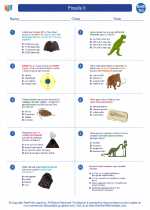Silicates
Silicates are minerals that are composed of silicon and oxygen, and may also contain other elements such as aluminum, potassium, or sodium. They are the most abundant group of minerals on Earth and make up the majority of the Earth's crust.
Structure
Silicate minerals are characterized by their structure, which consists of silicon-oxygen tetrahedra. These tetrahedra can be linked together in various ways to form different silicate mineral structures. The arrangement and bonding of these tetrahedra determine the physical and chemical properties of the silicate minerals.
Classification
Silicate minerals are classified into several groups based on their structure and chemical composition. The major groups of silicate minerals include:
- Framework Silicates (e.g. quartz, feldspar)
- Sheet Silicates (e.g. mica, clay minerals)
- Chain Silicates (e.g. pyroxene, amphibole)
- Single Tetrahedra (e.g. olivine)
Physical Properties
Silicate minerals exhibit a wide range of physical properties, including hardness, cleavage, color, and luster. These properties can be used to identify and differentiate between different silicate minerals.
Occurrence
Silicate minerals are found in a variety of geological environments, including igneous, metamorphic, and sedimentary rocks. They are also present in soils and are important constituents of the Earth's mantle and crust.
Uses
Many silicate minerals have practical applications in various industries. For example, quartz is used in glassmaking, feldspar is used in ceramics, and mica is used in electrical insulators and building materials.
Study Guide
To study silicates effectively, it is important to understand the following key concepts:
- The structure and bonding of silicon-oxygen tetrahedra in silicate minerals
- The classification and major groups of silicate minerals
- The physical properties and characteristics of silicate minerals
- The occurrence and geological significance of silicate minerals
- The practical applications and uses of silicate minerals
Students should also be familiar with the identification and distinguishing features of common silicate minerals, and be able to recognize them in hand samples or thin sections under a microscope.
Understanding silicates is crucial for anyone studying Earth science, geology, or mineralogy, as these minerals play a fundamental role in the composition and behavior of the Earth's crust and mantle.



